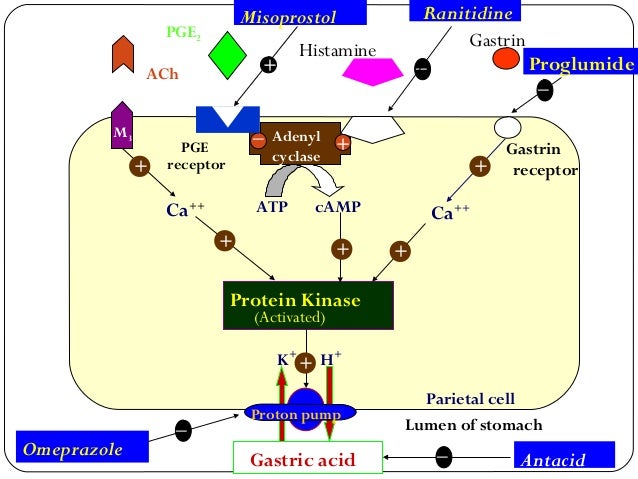Proton Pump Inhibitor Mechanism Of Action Pdf
The PPIs are well absorbed after oral dosing, and the simultaneous administration of antacids does not appear to affect their bioavailability. Food may delay the absorption of lansoprazole, pantoprazole, and rabeprazole, but this delay does not alter the area under the plasma concentration–time curve, which is a key factor in achieving clinical efficacy for these agents. Absorption of the enteric-coated agents may be erratic, and peak serum concentrations are not achieved until 2 to 5 hours after oral administration. Although the plasma half-life of the PPIs is short (24 hours) as a result of covalent binding to the H+,K+-ATPase. Newer PPIs inhibit H+,K+-ATPase more rapidly than omeprazole, and emerging clinical data support potential clinical benefits resulting from this pharmacologic property. All PPIs undergo significant hepatic metabolism. Because there is no direct toxicity from PPIs, dose adjustments are not required even in patients with significant renal or hepatic impairment.
However, there are significant genetic polymorphisms for one of the CYP isoenzymes involved in PPI metabolism, CYP2C19. Approximately 3% of white persons and 15% of Asians are deficient in CYP2C19. This polymorphism has been shown to substantially raise plasma levels of omeprazole, lansoprazole, and pantoprazole but not those of rabeprazole. Counter-strike download free. As a result of their requirement for concentration and activation in acidic compartments, the PPIs bind predominantly to those proton pumps that are actively secreting acid. Thus, the efficacy of the PPIs for inhibiting acid secretion is limited if they are administered during the fasting state, when only approximately 5% of the stomach's proton pumps are active.
With meal stimulation, in contrast, 60% to 70% of the proton pumps actively secrete acid. Thus, the PPIs are most effective if they are administered immediately before meals. For once-daily dosing, it is recommended that the PPIs be taken immediately before breakfast. Eradication of H. Pylori infection has been found to render PPIs somewhat less effective in elevating the gastric pH in patients with duodenal ulcer. The mechanism by which H. Pylori infection augments the pH-elevating effect of the PPIs is not clear.
Conceivably, this phenomenon might be a consequence either of alkaline ammonia produced from urea by the organism or, more likely, of the greater gastric bicarbonate secretion and lesser gastric acid secretion associated with ongoing infection. The elevation of gastric pH induced by the PPIs can affect the absorption of a number of medications. However, this antisecretory action rarely has clinically important effects on drug pharmacokinetics, except when the PPIs are given with ketoconazole or digoxin. Ketoconazole requires stomach acid for absorption, and this drug may not be absorbed effectively after PPIs have inhibited gastric acid secretion. Conversely, an elevated gastric pH facilitates the absorption of digoxin, resulting in higher plasma levels of this agent. If a patient requires both PPI and antifungal therapy, it is recommended that an agent other than ketoconazole be chosen.
For patients treated concomitantly with PPIs and digoxin, clinicians should consider monitoring plasma digoxin levels. Because the PPIs are metabolized by the CYP system, there is potential for them to alter the metabolism of other drugs that are eliminated by CYP enzymes.
Proton Pump Inhibitors Mechanism Of Action


Proton Pump Inhibitor Mechanism Of Action Pdf Free
Among the available PPIs, omeprazole appears to have the greatest potential for such drug interactions and has been shown to delay the clearance of warfarin, diazepam, and phenytoin. Lansoprazole, pantoprazole, and rabeprazole do not appear to interact significantly with drugs metabolized by the CYP system. Even with omeprazole, however, clinically important drug interactions are uncommon.
Inhibition of the proton pump in the parietal cells has been established as the main therapeutic principle in the treatment of acid-related diseases, such as peptic ulcer and gastro-oesophageal reflux. The proton pump inhi bitors are tailored for their purpose. They accumulate in the target cell, are activated by acid and bind strongly to the specific target - the proton pump.
The clinical superiority of the proton pump inhibitors is due not only to their high efficacy but also to the long duration of the acid inhibition in comparison with other antisecretory drugs. At present when drug discovery mostly relies on identification and characterization of potential targets by genome research, molecular biology, combinatorial chemistry and automated screening, it seems worthwhile to present the development of the tITst proton pump inhibitor - omeprazol- starting from a chemical structure with an observed antisecretory effect but also severe toxic effects that had to be eliminated. As always, basic and applied research operate luind in hand to optimize the delicate balance be tween efficacy and safety of a new drug. This goal often involves time and many different specialists.